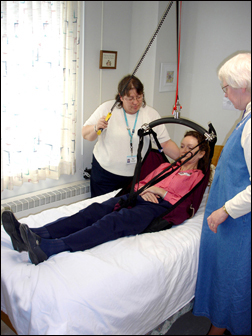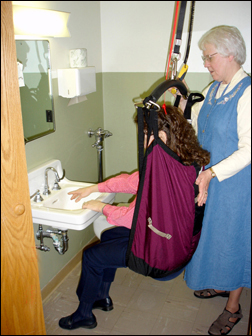Best practices -- Ceiling-mounted lift system
Health care industry
Ceiling-mounted lift system reduces common staff-injuries when lifting and moving residents
Prior to the use of ceiling-mounted lifts, care-staff-members would lift and move residents manually or with the use of various mechanical floor-based lifts. Manual lifting resulted in excessive stresses to the back and shoulders, and contributed to care-staff-members injuries. Even with the use of a floor-based lift, the working space within resident rooms was not always ideal for maneuvering the lift, resulting in an increased force requirement when positioning and moving the lift. Also, the lifts were difficult to push on carpeting.
After installation of the ceiling-mounted lift systems, employees can now perform various lifting and moving tasks with little physical effort. The lift systems have reduced the awkward postures and high force requirements commonly associated with lifting and moving residents. The ceiling-mounted lift system does not require the need for additional staff members to help with a lift and transfer. Staff members also feel the system has been a time-saver, because each ceiling-track system is provided with a trolley for lifting and is always readily available, versus looking for a lift and a coworker to help. Using the system was easy to learn and residents seem to prefer the new system.
|
Above left: The ceiling-mounted lift system can be used for lifting, turning, repositioning and transferring residents. Above right: Residents can be easily positioned during daily care activities. |
|
Disclaimer: Photographs of commercially available products posted on this site are for reference purposes only and do not imply any endorsement by the Minnesota Department of Labor and Industry. The best-practices ideas have been reviewed and posted solely at the discretion of the department and should only be considered as possible examples for reducing risk-factors, based on existing ergonomics guidelines. Employers and employees need to work together to identify and control ergonomics risk-factors within the workplace to better ensure changes made to a work process will be effective in reducing risk-factors and maintaining work efficiency.


